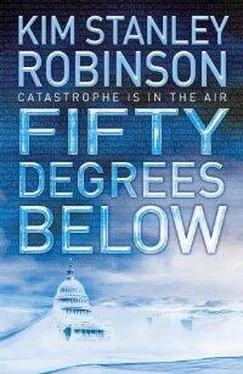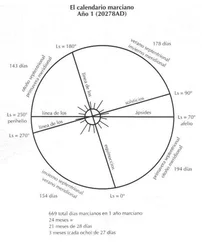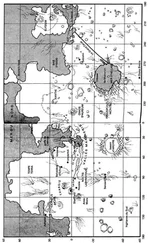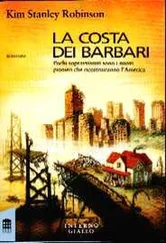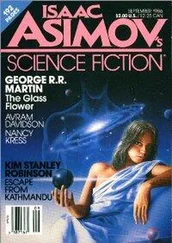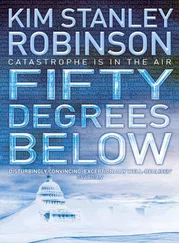“Hmmm. Maybe so. But I don’t think most people know.”
“No. Hey, are you done there? Will you check me on the bench press? My right elbow kind of locks up sometimes.”
So Frank held the handlebar outside her hand. A young woman, heavily tattooed on her arms, waited for the machine to free up.
Diane finished and Frank held out a hand to help her. She took it and hauled herself up, their grips tightening to hold. When she was up the young woman moved in to replace her, but Diane took up a towel and said, “Wait a second, let me wipe up the wet spot.”
“Oh I hate the wet spot,” the young woman said, and immediately threw a hand to her mouth, blushing vividly. Frank and Diane laughed, and seeing it the young woman did too, glowing with embarrassment. Diane gave the bench a final flourish and handed it over, saying, “There, if only it were always that easy!”
They laughed again and Frank and Diane moved to the next machine. Military press, leg curls; then Diane looked at her watch and said, “Oops, I gotta get going,” and Frank said “Me too,” and without further ado they were off to their respective locker rooms. “See you over there.” “Yeah, see you.”
Into the men’s room, the shower, ahhhh. Hot water must have been unusual in the hominid world. Hot springs, the Indian Ocean shallows. Then out on the street, the air still cool, feeling as benign as he had in a long time. And Diane emerged at the same time from the women’s locker room, transformed into work mode, except wetter. They walked over to NSF together, talking about a meeting they were scheduled to attend later in the day. Frank arrived in his office at eight a.m. as if it were any ordinary morning. He had to laugh.
The meeting featured a presentation by Kenzo and his team to Diane, Frank’s committee, and some of the members of the National Science Board, the group that oversaw the Foundation in somewhat a board-of-directors style, if Frank understood it correctly. By the time Frank arrived, a large false-color map of the North Atlantic was already on the screen. On it the red flows marking the upper reaches of the Gulf Stream broke apart and curled like new ferns, one near Norway, one between Iceland and Scotland, one between Iceland and Greenland, and one extending up the long channel between Greenland and Labrador.
“This is how it used to look,” Kenzo said. “Now here’s the summer’s data from the Argos buoy system.”
They watched as the red tendrils shrank in on themselves until they nearly met, at about the latitude of southern Ireland. “That’s where we’re at now, in terms of temperature. Here’s surface height.” He clicked to another false-colored map that revealed what were in effect giant shallow whirlpools, fifty kilometers wide but only a few centimeters deep.
“This is another before map. We think these downwelling sites were pretty stable for the last eight thousand years. Note that the Coriolis force would have the currents turning right, but the land and sea-bottom configurations make them turn left. So they aren’t as robust as they might be. And then, here’s what we’ve got now—see? The downwelling has clearly shifted to southwest of Ireland.”
“What happens to the water north of that now?” Diane asked.
“Well—we don’t know yet. We’ve never seen this before. It’s a fresh-water cap, a kind of lens on the surface. In general, water in the ocean moves in kind of blobs of relative freshness or salinity, you might say, blobs that mix only slowly. One team identified and tracked the great salinity anomaly of 1968 to ’82, that was a huge fresher blob that circled in the North Atlantic on the surface. It made one giant circuit, then sank on its second pass through the downwelling zone east of Greenland. Now with this fresh-water cap, who knows? If it’s resupplied from Greenland or the Arctic, it may stay there.”
Diane stared at the map. “So what do you think happened to cause this fresh-water cap?”
“It may be a kind of Heinrich event, in which icebergs float south. Heinrich found these by analyzing boulders dropped to the sea floor when the icebergs melted. He theorized that anything that introduces more fresh water than usual to the far North Atlantic will tend to interfere with downwelling there. Even rain can do it. So, we’ve got the Arctic sea ice break-up as the main suspect, plus Greenland is melting much more rapidly than before. The poles are proving to be much more sensitive to global warming than anywhere else, and in the north the effects look to be combining to freshen the North Atlantic. Anyway it’s happened, and the strong implication is that we’re in for a shift to the kind of cold-dry-windy climate that we see in the Younger Dryas.”
“So.” Diane looked at the board members in attendance. “We have compelling evidence for an ocean event that is the best-identified trigger event for abrupt climate change.”
“Yes,” Kenzo said. “A very clear case, as we’ll see this winter.”
“It will be bad?”
“Yes. Maybe not the full cold-dry-windy, but heck, close enough. The Gulf Stream used to combine with Greenland to make a kind of jet-stream anchor, and now the jet stream is likely to wander more, sometimes shooting straight down the continents from the Arctic. It’ll be cold and dry and windy all over the northern hemisphere, but especially in the eastern half of North America, and all over Europe.” Kenzo gestured at the screen. “You can bet on it.”
“And so … the ramifications? In terms of telling Congress about the situation?”
Kenzo waved his hands in his usual impresario style. “You name it! You could reference that Pentagon report about this possibility, which said it would be a threat to national security, as they couldn’t defend the nation from a starving world.”
“Starving?”
“Well, there are no food reserves to speak of. I know the food production problem appeared to be solved, at least in some quarters, but there were never any reserves built up. It’s just been assumed more could always be grown. But take Europe—right now it pretty much grows its own food. That’s six hundred and fifty million people. It’s the Gulf Stream that allows that. It moves about a petawatt northward, that’s a million billion watts, or about a hundred times as much energy as humanity generates. Canada, at the same latitude as Europe, only grows enough to feed its thirty million people, plus about double that in grain. They could up it a little if they had to, but think of Europe with a climate suddenly like Canada’s—how are they going to feed themselves? They’ll have a four- or five-hundred-million—person shortfall.”
“Hmm,” Diane said. “That’s what this Pentagon report said?”
“Yes. But it was an internal document, written by a team led by an Andrew Marshall, one of the missile defense crowd. Its conclusions were inconvenient to the administration and it was getting buried when someone on the team slipped it to Fortune magazine, and they published it. It made a little stir at the time, because it came out of the Pentagon, and the possibilities it outlined were so bad. It was thought that it might influence a vote at the World Bank to change their investment pattern. The World Bank’s Extractive Industries Review Commission had recommended they cut off all future investment in fossil fuels, and move that same money into clean renewables. But in the end the World Bank board voted to keep their investment pattern the same, which was ninety-four percent to fossil fuels and six percent to renewables. After that the Pentagon report experienced the usual fate.”
“Forgotten.”
“Yes.”
“We don’t remember our reports either,” Edgardo said. “There are several NSF reports on this issue. I’ve got one here called ‘Environmental Science and Engineering for the twenty-first Century, The Role of the National Science Foundation.’ It called for quadrupling the money NSF gave to its environmental programs, and suggested everyone else in government and industry do the same. Look at this table in it—forty-five percent of Earth’s land surface transformed by humans—fifty percent of surface fresh water used—two-thirds of the marine fisheries fully exploited or depleted. Carbon dioxide in the atmosphere thirty percent higher than before the industrial revolution. A quarter of all bird species extinct.” He looked up at them over his reading glasses. “All these figures are worse now.”
Читать дальше
Конец ознакомительного отрывка
Купить книгу
